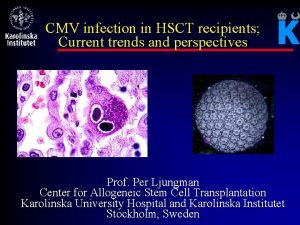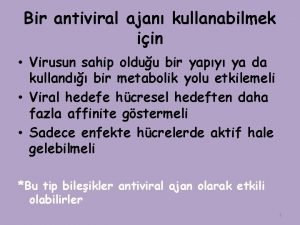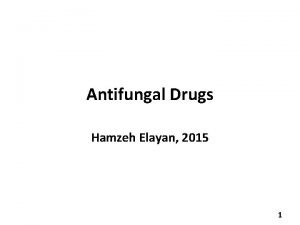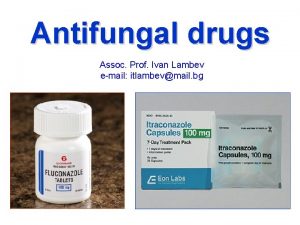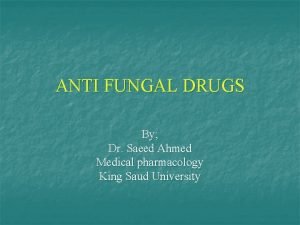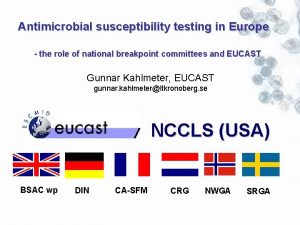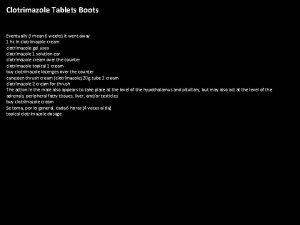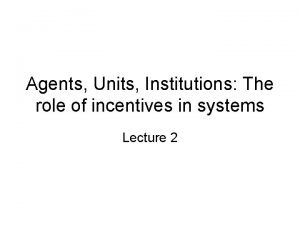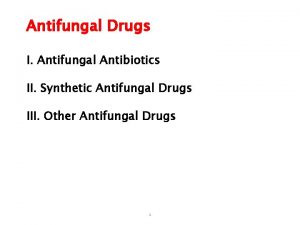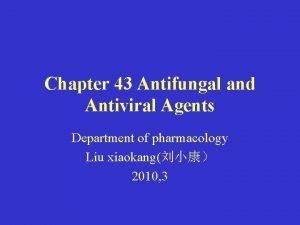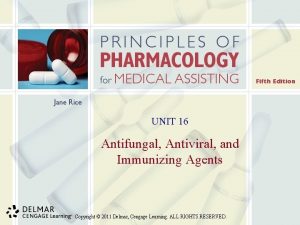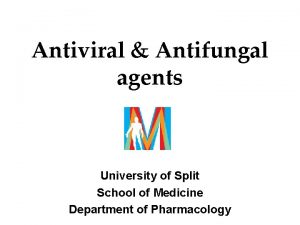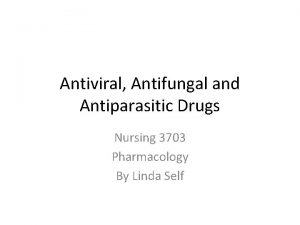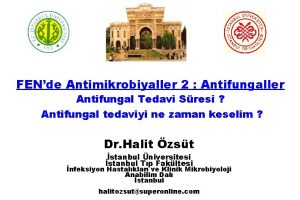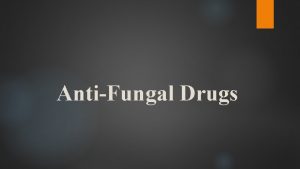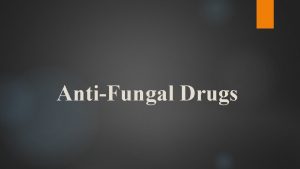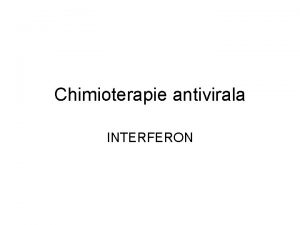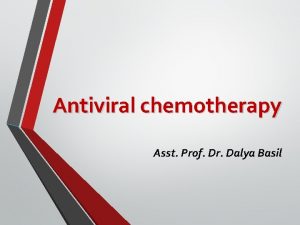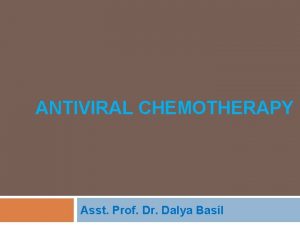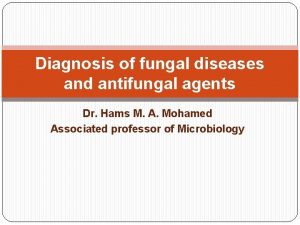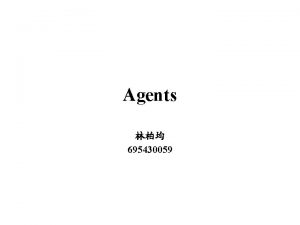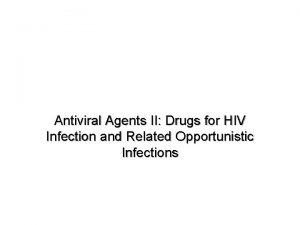THE ROLE OF ANTIFUNGAL AND ANTIVIRAL AGENTS IN





















- Slides: 21

THE ROLE OF ANTIFUNGAL AND ANTIVIRAL AGENTS IN PRIMARY DENTAL CARE Matt Dickie

Introduction � Significantly limited spectrum of antifungal and antiviral drugs when compared to the range of antibiotics. � Essentially there are three antifungal agents and 2 antiviral agents.

Anti Fungals � Two main types: Polyenes ◦ 1950 s ◦ Interacts with fungal cell wall causing loss of cytoplasmic content. ◦ Poorly absorbed in the gut- (topical use required) ◦ Lozenge or oral suspension ◦ Poor compliance due to taste �NYSTATIN ORAL SUSPENSION (100, 000 units/ml)

Anti Fungals Azoles ◦ ◦ 1970 s+1980 s Inhibits biosynthesis of ergosterol (Component of cell wall) Fungistatic action Underlying cause needs addressed at the same time ◦ Miconazole is poorly absorbed- topical use �MICONAZOLE OROMUCOSAL GEL 20 mg/g ◦ Fluconazole is well absorbed- systemic use �FLUCONAZOLE CAPSULES 50 mg

Interactions

Things to look out for

Candidosis “ The disease of the diseased” � Pseudomembranous � Acute Erythematous � Chronic Erythematous (Denture Stomatitis) � Chronic Hyperplastic � Angular Cheilitis

Pseudomembranous White plaque like lesion- can be wiped off � Soft palate and buccal mucosa most frequent � � Most likely cause in primary care is use of a Corticosteroid inhaler ◦ Advise to rinse mouth following use. � If no resolution following local measures then: ◦ Fluconazole 50 mg capsule, once daily for 7 days. � If Fluconazole contraindicated then: ◦ Nystatin (100, 000 units/ml) 1 ml after food, 4 times daily for 7 days

Acute Erythematous Uncomfortable erythematous patches on oral mucosa � Typically dorsum of tongue � � Frequently related to broad spectrum antibiotics ◦ Resolution on completion of antibiotic course � Alternatively fluconazole can be prescribed as before. ◦ Fluconazole 50 mg capsule, once daily for 7 days. � Miconazole can also be prescribed and used topically ◦ Miconazole oromucosal gel 20 mg/ml, pea sized amount 4 times daily � Again if azoles contraindicated then Nystatin.

Chronic Erythematous “Denture Stomatitis” Most frequent form in primary care � Erythema of mucosa beneath partial or complete denture. � Most pt’s unaware of signs � � � Predisposing factors include nocturnal wear and/or poorly fitting appliances Local measures include improving denture hygiene ◦ Immersion in dilute sodium hypochlorite for 15 mins twice daily ◦ Alternatively Chlorhexidine 0. 2% if any metal components. ◦ Removal of denture as much as possible during the process.

Chronic Erythematous “Denture Stomatitis” � � Miconazole gel can be applied to the fitting surface of the denture 4 times/day A new denture maybe require if there has been hyphal infiltration into the fitting surface of the acrylic. Why this patient? Why now? Has then been any changes that might need investigated? Poorly controlled or undiagnosed diabetes for example

Chronic Hyperplastic Most prevalent in middle aged men that are smokers. � Generally asymptomatic � If untreated then 5 -10% undergo malignant change � Clinically: bilateral white patch at the commissures of the mouth. � Histologically: hyphal invasion of epithelium � Systemic Fluconazole � Smoking cessation required. � Recurrence common with continued smoking � Refer for specialist assessment (Incisional biopsy) �

Angular Cheilitis Corners of the mouth � Typically candidal and bacterial infection � Related to intra-oral infection � Elimination of intra-oral candidal infection � Topical application of miconazole gel, which has dual action on candida and gram positive bacteria � � If a lack of response then refer ◦ ? Haematinic deficiency or diabetes issue

Opportunistic Infections � � � Drug therapys are a great adjunct to treatment However, main focus must be to identify and eliminate the underlying predisposing factors to prevent reoccurrence. On many occasions primary dental care may be the patients initial presentation.

Viral Infections � 3 groups to consider in primary care ◦ Herpes �HSV-1: primary herpetic gingivostomatis �Recurrent herpes labialis �Varicella Zoster: Shingles ◦ HPV �Orofacial warts or papiloma �Oropharyngeal SCC ◦ Coxsachie �Hand foot and Mouth �Herpangina � However, antivirals arent prescribed for HPV or coxsachie

Anti Virals � Aciclovir and penciclovir are the drugs of choice. Work by inhibiting the replication of the virus. � Therefore needs to be taken as early as possible. � � Furthermore, they need to be taken frequently due to the short half life inside the cells.

Primary Herpetic Gingivostomatitis (PHGS) Young children � No antivirals routinely prescribed � Importance placed on maintance of fluid levels, analgesics and a soft diet. � Furthermore chlorhexidine can be utilised to help with plaque control. � � Typical resolution in 10 -14 days.

Secondary Herpes Simplex Infection "Cold sore" � 30% of pt's who have had PHGS will suffer from this. Most commonly lips Can affect any part of the face � Typical cycle: � � ◦ ◦ ◦ Prodomal tingle Blister Erosion Crusting Healing within 7 -14 days

Secondary Herpes Simplex Infection "Cold sore" � Topical Aciclovir 5%, 5 times daily on affected area. � Is still effective in the blister stage. � � If pt very susceptible then prophylactic systemic Aciclovir 200 mg can be prescribed. 3 time daily for 3 months

Zaricella Zoster Reactivation "Shingles" � Affect Sensory Nerves � Can affect the Trigeminal Nerve (CN 5) ◦ If mand or max branch then ? Tooth ache like symptoms � May present before mucosal or cutaneous lesions. ◦ Lack of obvious pathology then consider shingles � Treatment: ◦ Analgesics ◦ Aciclovir 800 mg, 5 times daily, 7 days

Thanks for listening
 Second antiviral pill
Second antiviral pill Idoksüridin
Idoksüridin Classification of antifungal drugs
Classification of antifungal drugs Mechanism of action of antifungal drugs
Mechanism of action of antifungal drugs Mechanism of antifungal drugs
Mechanism of antifungal drugs Flucytosine mechanism of action
Flucytosine mechanism of action Antifungal sensitivity test
Antifungal sensitivity test Clotrimazole ear drops boots
Clotrimazole ear drops boots Role of economic agents
Role of economic agents Role of economic agents
Role of economic agents Azure web role vs worker role
Azure web role vs worker role Krappmann modell
Krappmann modell Statuses and their related roles determine the structure
Statuses and their related roles determine the structure Hát kết hợp bộ gõ cơ thể
Hát kết hợp bộ gõ cơ thể Bổ thể
Bổ thể Tỉ lệ cơ thể trẻ em
Tỉ lệ cơ thể trẻ em Gấu đi như thế nào
Gấu đi như thế nào Tư thế worm breton
Tư thế worm breton Alleluia hat len nguoi oi
Alleluia hat len nguoi oi Các môn thể thao bắt đầu bằng tiếng đua
Các môn thể thao bắt đầu bằng tiếng đua Thế nào là hệ số cao nhất
Thế nào là hệ số cao nhất
